Summary: Since February, US equities have risen more than 20%. Equities outside the US have risen 16%. A tailwind for this rally has been the bearish positioning of investors, with fund managers' cash in February at the highest level since 2001. Similarly, their equity allocations in February had only been lower in mid-2011 and mid-2012, periods which were notable lows for equity prices during this bull market.
Remarkably, allocations to cash in July were even higher than in February, and fund managers became underweight equities for the first time in 4 years. Investors dove into the safety of bonds, with allocations rising to a 3 1/2-year high in June and July.
Now in August, cash allocations are only slightly lower than in February and allocations to equities only slightly higher. Both are about one standard deviation away from their long term mean. Overall, fund managers' defensive positioning supports higher equity prices in the month(s) ahead.
Allocations to US equities had been near 8-year lows over the past year and half, during which the US has outperformed most of the world. That has now changed: exposure to the US is at a 20-month high. There is room for exposure to move higher, but the tailwind for the US due to excessive bearish sentiment has mostly passed. That's also the case for emerging markets which have been the best performing equity region so far in 2016. European equity markets, which have been the consensus overweight and also the world's worst performing region, are now the contrarian long trade within equities.
Among the various ways of measuring investor sentiment, the BAML survey of global fund managers is one of the better as the results reflect how managers are allocated in various asset classes. These managers oversee a combined $600b in assets.
The data should be viewed mostly from a contrarian perspective; that is, when equities fall in price, allocations to cash go higher and allocations to equities go lower as investors become bearish, setting up a buy signal. When prices rise, the opposite occurs, setting up a sell signal. We did a recap of this pattern in December 2014.
Let's review the highlights from the past month.
Cash: Fund managers cash levels at the equity low in February were 5.6%, the highest since the post-9/11 panic in November 2001 and lower than at any time during the 2008-09 bear market. This was an extreme that has normally been very bullish for equities. Remarkably, with the SPX 20% higher, cash in July was even higher (5.8%) and at the highest level in 14 years (since November 2001). That has moderated only slightly in August, falling to 5.4%. High cash levels are supportive of further gains in equities in the month(s) ahead (enlarge any image by clicking on it)

Global equities: Fund managers were just +5% overweight equities at their low in February; since 2009, allocations had only been lower in mid-2011 and mid-2012, periods which were notable lows for equity prices during this bull market. Despite the rally since February, allocations in July were even lower, dropping to -1% underweight. This was the first time in 4 years that fund managers were underweight equities. Allocations increased to +9% overweight in August; this is still 0.8 standard deviations below the long term mean, and supportive of further gains in equities in the month(s) ahead.
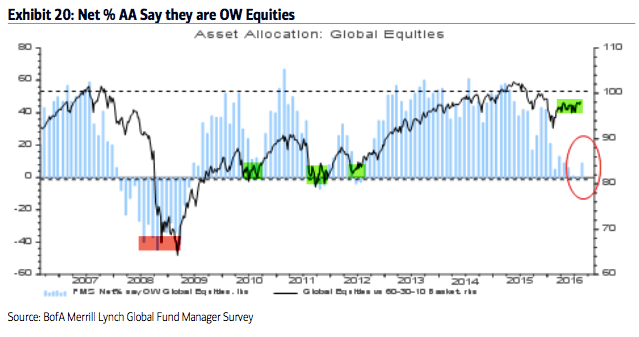
US equities: US exposure has been near an 8-year low during the past year and a half, during which US equities have outperformed. US equities have been under-owned. That has now changed, with allocation rising to +11% overweight, a 20-month high. There is room for this to move higher, but the tailwind for the US due to excessive bearish sentiment has mostly passed.

European equities: Fund managers have been excessively overweight European equities for more than a year, during which time EZ equities have underperformed. In July, for the first time in 3 years, allocations to EZ were underweight (by -4%). That improved slightly to +1% overweight in August. Although underweighted allocations can become more extreme, the largest risk to underperformance due to excessive bullish sentiment has passed.
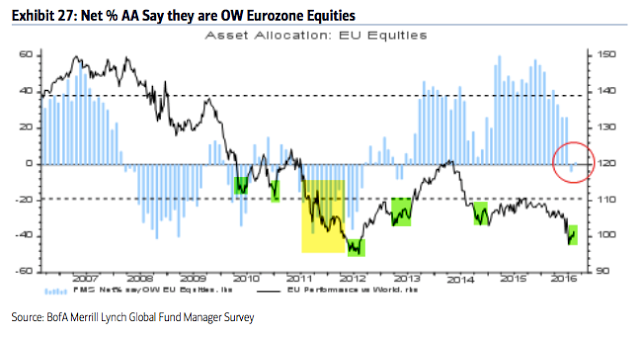
Japanese equities: Allocations to Japan have been falling in 2016 as the region has underperformed. Allocations increased slightly in August to -1% underweight from -7% underweight in June and July (which were the lowest allocations since December 2012).
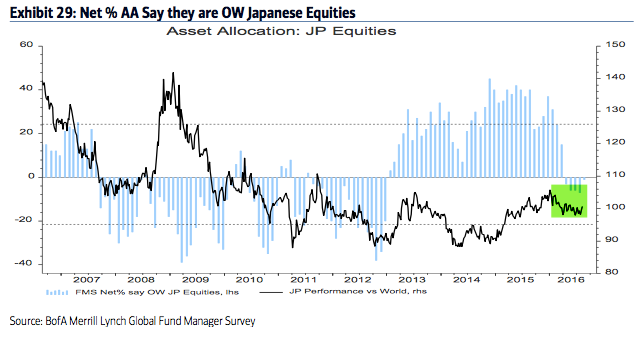
Emerging markets equities: In January, allocations to emerging markets fell to their second lowest in the survey's history (-33% underweight), an extreme comparable only to early-2014 from which the region began to strongly outperform for the next half a year. Allocations have since risen to +13% overweight, the highest in 23 months. This is now nearly equal to its long term mean. The region has outperformed the rest of the world so far 2016. There is room for exposure to increase further but allocations are now nearly back to where the rally in mid-2014 failed.
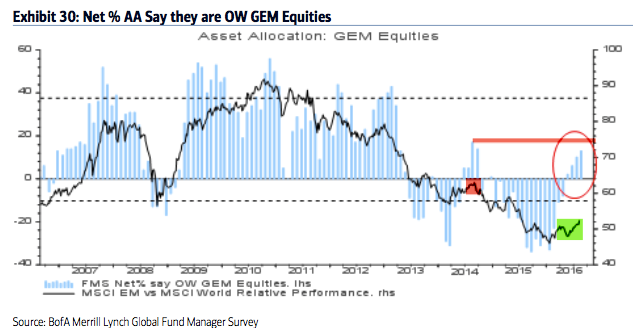
Global bonds: Fund managers are -43% underweight bonds, a fall from -35% in July (which was near a 3.5 year high allocation). Bonds outperformed in the 10 months before the current equity rally began in February, as allocations increased from -64% underweight in December (a 2-year low). Note that bonds have historically started to underperform when allocations rise to -20% underweight (red shading).
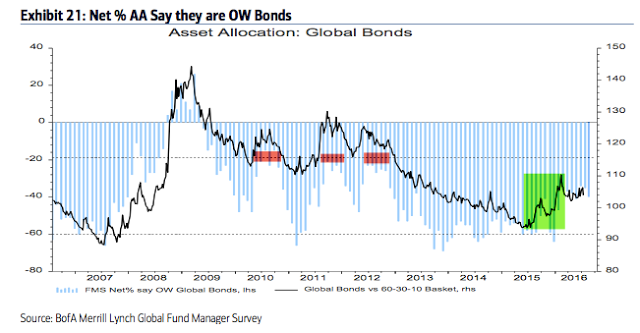
In February, 16% of fund managers expected a weaker economy in the next 12 months, the lowest since December 2011. Investors are still pessimistic, with only 23% expecting a stronger economy in the next year. This explains the low allocations to equities and high allocations to cash.

Commodities: Allocations to commodities remained at a 3.5-year high of -4% underweight. This is neutral relative to the long-term mean. In comparison, in February, allocations were near one of the lowest levels in the survey's history (-29% underweight). The improvement in commodity allocations goes together with that for emerging markets.
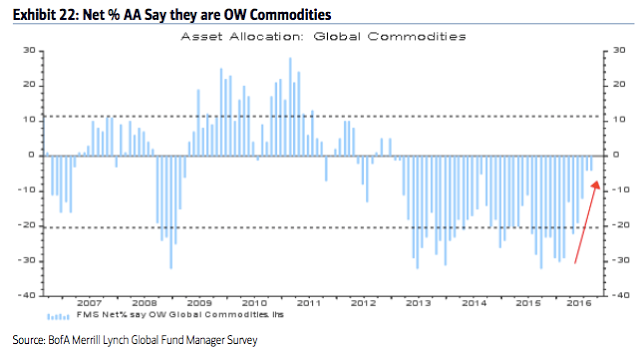
Sectors: Relative to history, managers are extremely overweight cash. They are far more overweight bonds than equities. Overall, this is very defensive positioning.
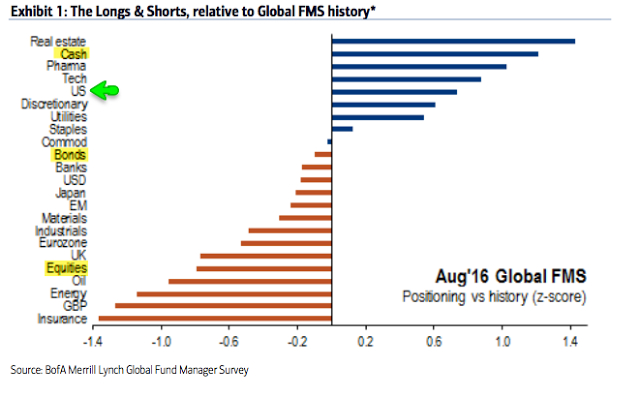
In July, fund managers risk appetite was the lowest since July 2012, a level from which SPX rose 10% over the following two months.
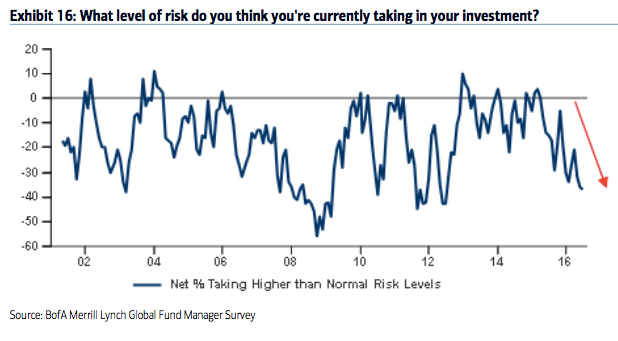
A record percent of fund managers bought downside protection for the next 3 months in July. That moderated slightly in August.
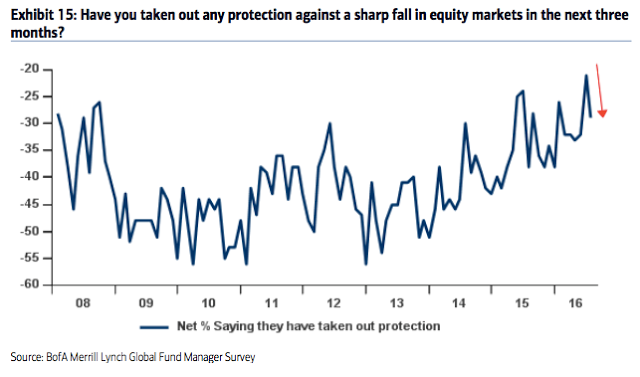
Survey details are below.
- Cash (5.4%): Cash balances decreased to 5.4% from 5.8%. Cash balances were higher in July than in February (5.6%) and the highest since November 2001. Typical range is 3.5-5%. BAML has a 4.5% contrarian buy level but we consider over 5% to be a better signal.
- Equities (-1%): A net +9% are overweight global equities, up from -1% in July and just above the +5% overweight in February. Over +50% is bearish. A washout low (bullish) is under +15%.
- Regions:
- US (+11%): Exposure to the US rose from -15% underweight in May to +11% overweight in August. The US is overweight for only the second time in 17 months.
- Europe (+1%): Exposure to Europe dropped from +26% overweight in June to -4% underweight in July, the first underweight for Europe in 3 years. This rose to +1% overweight in August.
- Japan (-1%): Exposure to Japan rose to -1% underweight from -7% underweight in July and June. Funds were -20% underweight in December 2012 when the Japanese rally began.
- EM (+13%): Exposure to EM rose from +6% overweight in June to +13% overweight in August - a 23-month high. Exposure was -33% underweight in January when the regional rally began. -34% underweight in September 2015 was the lowest in the survey's history.
- Bonds (-43%): A net -43% are underweight bonds, a rise from -64% in December but a fall from-35% in July. Note that global bonds started to underperform in mid-2010, 2011 and 2012 when they reached -20% underweight.
- Commodities (-4%): A net -4% are underweight commodities - a 3.5 year high - an improvement from -12% in June and unchanged from July. Higher commodity exposure goes in hand with improved sentiment towards EM.
- Macro: 23% expect a stronger global economy over the next 12 months; in February, 16% expected a weaker economy, the most pessimistic since December 2011.
